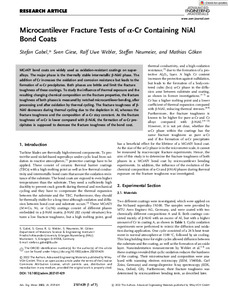| dc.date.accessioned | 2023-08-08T07:55:24Z | |
| dc.date.available | 2023-08-08T07:55:24Z | |
| dc.date.issued | 2022-01-08 | |
| dc.identifier | doi:10.17170/kobra-202308048576 | |
| dc.identifier.uri | http://hdl.handle.net/123456789/14975 | |
| dc.description.sponsorship | H2020 European Research Council. Grant Numbers: 725483, 949626; Open access funding enabled and organized by Projekt DEAL | eng |
| dc.language.iso | eng | |
| dc.rights | Namensnennung 4.0 International | * |
| dc.rights.uri | http://creativecommons.org/licenses/by/4.0/ | * |
| dc.subject | bond coats | eng |
| dc.subject | fracture toughnesses | eng |
| dc.subject | intermetallics | eng |
| dc.subject | microcantilever bending | eng |
| dc.subject.ddc | 600 | |
| dc.subject.ddc | 660 | |
| dc.title | Microcantilever Fracture Tests of α-Cr Containing NiAl Bond Coats | eng |
| dc.type | Aufsatz | |
| dcterms.abstract | MCrAlY bond coats are widely used as oxidation-resistant coatings on superalloys. The major phase is the thermally stable intermetallic β-NiAl phase. The addition of Cr increases the oxidation and corrosion resistance but leads to the formation of α-Cr precipitates. Both phases are brittle and limit the fracture toughness of these coatings. To study the influence of thermal exposure and the resulting changing chemical composition on the fracture properties, the fracture toughness of both phases is measured by notched microcantilever bending, after processing and after oxidation by thermal cycling. The fracture toughness of β-NiAl decreases during thermal cycling due to the depletion in Al, whereas the fracture toughness and the composition of α-Cr stay constant. As the fracture toughness of α-Cr is lower compared with β-NiAl, the formation of α-Cr precipitates is supposed to decrease the fracture toughness of the bond coat. | eng |
| dcterms.accessRights | open access | |
| dcterms.creator | Gabel, Stefan | |
| dcterms.creator | Giese, Sven | |
| dcterms.creator | Webler, Ralf Uwe | |
| dcterms.creator | Neumeier, Steffen | |
| dcterms.creator | Göken, Mathias | |
| dc.relation.doi | doi:10.1002/adem.202101429 | |
| dc.relation.projectid | 725483, 949626 | |
| dc.subject.swd | Verbindungsschicht | ger |
| dc.subject.swd | Bruchzähigkeit | ger |
| dc.subject.swd | Intermetallische Verbindungen | ger |
| dc.subject.swd | Biegung | ger |
| dc.subject.swd | Thermomechanische Eigenschaft | ger |
| dc.type.version | publishedVersion | |
| dcterms.source.identifier | eissn:1527-2648 | |
| dcterms.source.issue | Issue 7 | |
| dcterms.source.journal | Advanced Engineering Materials | eng |
| dcterms.source.volume | Volume 24 | |
| kup.iskup | false | |
| dcterms.source.articlenumber | 2101429 | |


